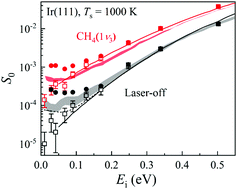Towards bridging the structure gap in heterogeneous catalysis: the impact of defects in dissociative chemisorption of methane on Ir surfaces†
Abstract
A quantitative understanding of the role played by defect sites in heterogeneous catalysis is of great importance in designing new and more effective catalysts. In this work, we report a detailed dynamic study of a key step in methane steam reforming under experimentally relevant conditions on a new high-dimensional potential energy surface determined from first principles data with the aid of machine learning, with which the interactions of CH4 with both the flat Ir(111) and stepped Ir(332) surfaces are described. In particular, we argue based on our simulations that the experimentally observed “negatively activated” dissociative chemisorption of methane on Ir surfaces could be due to a combined effect of defects and high substrate temperature, which lowers the reaction barrier relative to that on terraces. Furthermore, a model based on dynamic information of trapping and reaction channels is proposed, which allows a quantitative prediction of the initial sticking probability for different defect densities, thus helping to close the so-called structure gap in heterogeneous catalysis.

- This article is part of the themed collection: Emerging AI Approaches in Physical Chemistry


 Please wait while we load your content...
Please wait while we load your content...